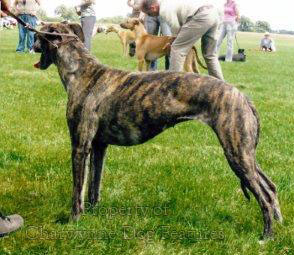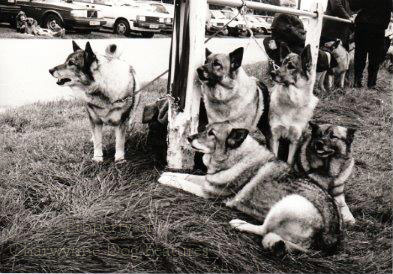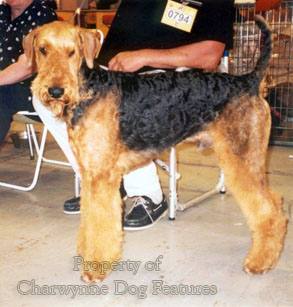205 Chipping Away at Cheats
CHIPPING AWAY AT THE CHEATS
by David Hancock

 As a nation, Britain is often accused of preferring the past to the present, being suspicious of science and sometimes being cynical about the real value of technological change. In the world of dogs however, we have almost a worship of the bizarre, witness the abnormally hairy, excessively wrinkled, virtually hairless and physically deformed breeds we import, buy and sell and shamelessly promote. The pursuit of the exotic, the strange, the freaks and the extremes of coat, shape and size are not modern. Four hundred years ago, the celebrated Dr. Caius was accusing "we Englishe" of being "greedy gaping gluttons after novelties. And covetous...of things...seldom, Rare, strange and hard to get".
As a nation, Britain is often accused of preferring the past to the present, being suspicious of science and sometimes being cynical about the real value of technological change. In the world of dogs however, we have almost a worship of the bizarre, witness the abnormally hairy, excessively wrinkled, virtually hairless and physically deformed breeds we import, buy and sell and shamelessly promote. The pursuit of the exotic, the strange, the freaks and the extremes of coat, shape and size are not modern. Four hundred years ago, the celebrated Dr. Caius was accusing "we Englishe" of being "greedy gaping gluttons after novelties. And covetous...of things...seldom, Rare, strange and hard to get".
Thankfully, this interest in the new, the novel and the newly- introduced from dog people is accompanied by a welcome for most veterinary advances and many technological innovations. The technology of the microchip has transformed our daily lives and for the purpose of identifying individual dogs now presents us with a startlingly effective way of achieving immediacy of proof. Tattooing can be seen by both owner and criminal and despite its advantages, I cannot get out of my mind the case in which a dog-thief cut out the tattooed skin to destroy the evidence of identity.
Gene identification is on the way too but lacks immediately available evidence for early resolution of a dispute. The alleged possession by pit bullterriers alone of the myosin gene has been reported but I suspect that many breeds with this conformation and muscular power display such a gene too. DNA testing may in time provide more precise breed identity but presents a rather laborious process. For the immediate identification of one particular dog however 'identichipping' has to be the way ahead of us.

Ten or so years ago, a colleague of mine had a quite magnificent brindle coursing greyhound bitch. Unusually, she simply didn't have any distinguishing marks, whether white toes, finching or distinctive striping. She disappeared one day from her exercise yard, clearly stolen as the signs of forced entry indicated. The following summer, my colleague went to a lurcher show in a distant county and there being judged in the ring was his bitch. He called her and she immediately tried to come to him. He tried to reclaim her on the spot but met determined opposition and called the police. The police were at a disadvantage; the dog responded to both the new and the old owner and had no physical features which either could point to. Eventually my colleague had to buy his own dog to get her back!
Twenty years ago I lived near a breeder, with a high reputation in his breed, of West Highland White terriers. From my knowledge of his kennel, breeding stock and programme and his sales records, he was evidently selling young pups, purchased from other less well-known breeders, as being the progeny of his bitches whelping at roughly the same time. They were admittedly being sold to pet homes. But their purchasers were being cheated and papers being falsified. Can you tell one very young Westie puppy from another? I mentioned this outrage to another breeder in the same breed, who accepted that it was disgraceful but was disinclined to do anything about it.
Thirty years ago, I was working in Germany and read about a fiercely-contested, bitterly-conducted and protracted case in which the ownership of a wolfspitz was the bone of contention. Apparently, a new fancier had chosen a pup from a four week-old litter and a month later returned to collect him. He arrived at the breeder's kennel to find one pup remaining but he felt sure it was not the one he had paid a deposit on. Unconvinced by the breeder's assurances that this remaining pup was the one he had booked, he traced the other five purchasers of pups from this same litter of six. He discovered that three of them had been given a free choice of the six pups. The breeder agreed that this was so, but that not one of the three had chosen the complainant's pup. How difficult to resolve such a case!
Self-coloured adult dogs in the spitz breeds are hard enough to differentiate but small puppies! that's even more so. Forty years ago when I was in Singapore I came across a court case in which a dog-dealer was sued by the owner of a stolen chow for the improper possession of his dog. The wily dog-dealer produced three deep mahogany chows in court and the aggrieved owner was challenged to identify his dog. He failed! Perhaps the famed aloofness of the breed played a part in this. Their owners may know them but I often have difficulties identifying individual dogs in breeds such as chows, Finnish spitz, Pharoah hounds, Old English sheepdogs and Sussex spaniels. How do judges manage to?
A year ago, a Crufts' judge told me that she had once had to send a dog out of the ring because she knew it was not the dog identified by name in the schedule for that class; the offending exhibitor didn't bat an eyelid! Just over forty years ago, when working for a vet in Bath as a young teenager, I can recall Mollie Harbutt of the well-known "Bengal" Airedales, informing the vet of a fellow exhibitor regularly showing the "wrong" dog. She suspected he had used one outstanding dog to get two others "made up". Such behaviour demands action from those who know about it and seek high standards in life. It also calls out for a guaranteed method of identifying dogs.
Much more recently we have the case of the "dyed lurcher". Mrs. Dorothy Williams of Bournemouth had her lurcher "Wallace" stolen from an RSPCA boarding kennel and traced it to a farm near Dorchester. The dog had been dyed brown but an irrefutable identification was provided by a scanner as "Wallace" had been identichipped. I wonder if any of the stolen Boxers could be reclaimed in this way? Less than 50% of lost pets are ever reunited with their owners. 
At the meeting in Berne on the 7th of June, 1994, between the Kennel Club, the American Kennel Club and the Federation Cynologigue Internationale, the identification of dogs was on the agenda. Item 4 was "to seek ways of achieving common ground on dog identification". It was agreed that all the technical information available indicated that the microchip would become the global method. The Kennel Club pointed out that the "Balai Directive" had accepted that the microchip was to be the method of identifying animals across international borders. All parties emphasised that it was in everybody's interests for the standardisation of both chips and scanners to take place or at the very least for scanners to be able to read different countries' systems. So the big boys have backed the chip!
In England however there is a contradiction in the Kennel Club's support for the microchip system of identifying dogs. Such a system can only work if there is a national register of dogs carrying their own unique "identity card" in this way. The Kennel Club is strongly against a national registration scheme for dogs and has lobbied powerfully against it. Surely you cannot have identification by microchip without a register of the owners of the dogs carrying one. Such a register would have to be national and the Kennel Club has accepted that scanners must be international. If this does not mean that they accept national "registration" then they are playing with words.
The best way for us to protect our dogs from thieves is to have a foolproof invisible method of identifying them. The best way to prevent cheating in the show ring by exhibiting a dog other than the one named in the schedule is to introduce an identification scheme. The best way to get your lost dog returned is to have your ownership listed on a national register, linked to a unique "identity card" on the dog. The number one killer of dogs in the UK is the destruction of unidentified strays.
I am not against tattooing and blindly in favour of microchipping. It may well be that tattooing is the best answer for whelps with subsequent purchasers having the personal choice of microchipping later. I am wholeheartedly in favour of taking every step made available to us to reduce the scope of criminals and to thwart the cheats. A strong desire to win can bring out the nastier side of human nature, whatever the sport or competition. The fact that modern technology has given us the chance of a unique identity mark for our dogs is one we should eagerly take. So often in contemporary life we hear of the bad guys winning; here is the opportunity for the good guys to get ahead. It is naive perhaps foolish to rely solely on the integrity of human beings in times when standards of behaviour are universally low. Those with authority in the world of dogs are not reknowned for their vision. Here is an opportunity for them to grasp. Defeating criminals and frustrating cheats in dogdom can be made easier -- chips can be good for you!